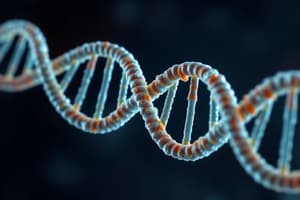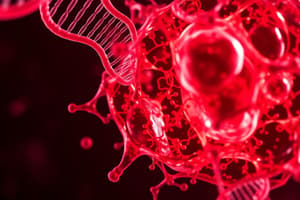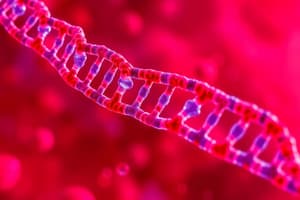Podcast
Questions and Answers
What is the primary purpose of homeostasis in cells?
What is the primary purpose of homeostasis in cells?
- To maintain a constant internal environment despite external changes. (correct)
- To regulate the synthesis of proteins.
- To create new genetic material.
- To increase the speed of cell division.
Which of the following is NOT a morphological feature found in a metaphase chromosome?
Which of the following is NOT a morphological feature found in a metaphase chromosome?
- Secondary constriction
- Centromere
- Telomeres
- Nucleolus (correct)
What is the main difference between exons and introns?
What is the main difference between exons and introns?
- Exons code for proteins, while introns do not. (correct)
- Introns regulate gene expression, while exons do not.
- Exons are found in prokaryotic cells, while introns are found in eukaryotic cells.
- Exons are transcribed, while introns are not.
What is the role of a promoter sequence in gene expression?
What is the role of a promoter sequence in gene expression?
Which of the following statements about DNA replication is TRUE?
Which of the following statements about DNA replication is TRUE?
What is the significance of the banding pattern observed in chromosomes?
What is the significance of the banding pattern observed in chromosomes?
What is the major component of the nuclear envelope?
What is the major component of the nuclear envelope?
What is the primary function of Polymerase Chain Reaction (PCR)?
What is the primary function of Polymerase Chain Reaction (PCR)?
What is the primary function of the nuclear basket?
What is the primary function of the nuclear basket?
How can cells regulate the sets of proteins they produce?
How can cells regulate the sets of proteins they produce?
What characteristic of the water molecule results in its uneven charge distribution?
What characteristic of the water molecule results in its uneven charge distribution?
Which of the following is NOT a characteristic of membrane lipids?
Which of the following is NOT a characteristic of membrane lipids?
What is the main consequence of spontaneous mutations?
What is the main consequence of spontaneous mutations?
Under what conditions might a cell enter the G0 phase?
Under what conditions might a cell enter the G0 phase?
What is the significance of a centromere located near the end of a chromosome?
What is the significance of a centromere located near the end of a chromosome?
What is the role of restriction enzymes in recombinant DNA technology?
What is the role of restriction enzymes in recombinant DNA technology?
What is the purpose of the lipid tail in the cell membrane?
What is the purpose of the lipid tail in the cell membrane?
What is the difference between a saturated and an unsaturated fatty acid?
What is the difference between a saturated and an unsaturated fatty acid?
What are the four families of small organic molecules? (Check all that apply)
What are the four families of small organic molecules? (Check all that apply)
What is an example of a process that requires a DNA template?
What is an example of a process that requires a DNA template?
What is a characteristic of all individuals of the same species, same sex, and good health?
What is a characteristic of all individuals of the same species, same sex, and good health?
Which of the following is NOT an example of long-distance communication between cells?
Which of the following is NOT an example of long-distance communication between cells?
What is the role of the nucleolus during protein synthesis?
What is the role of the nucleolus during protein synthesis?
What is the difference between transcription and translation?
What is the difference between transcription and translation?
What is the key difference between saturated and unsaturated fatty acids?
What is the key difference between saturated and unsaturated fatty acids?
What is the function of the internal membrane between the two monolayers?
What is the function of the internal membrane between the two monolayers?
What is the role of primers in DNA replication?
What is the role of primers in DNA replication?
What is the primary function of Polymerase α (alpha) in DNA replication?
What is the primary function of Polymerase α (alpha) in DNA replication?
What is the process of converting cytosine to uracil called?
What is the process of converting cytosine to uracil called?
What is the main function of regulatory sequences in gene expression?
What is the main function of regulatory sequences in gene expression?
Which of the following characteristics applies to unipotent cells?
Which of the following characteristics applies to unipotent cells?
What is the significance of the nuclear envelope breaking down during mitosis?
What is the significance of the nuclear envelope breaking down during mitosis?
What is the primary function of activator proteins regarding gene expression?
What is the primary function of activator proteins regarding gene expression?
Which of the following is a function of the ectoderm during embryonic development?
Which of the following is a function of the ectoderm during embryonic development?
What is the significance of the leading strand during DNA replication?
What is the significance of the leading strand during DNA replication?
Which of the following is NOT a characteristic of euchromatin?
Which of the following is NOT a characteristic of euchromatin?
What is the primary function of antibiotics in a biological context?
What is the primary function of antibiotics in a biological context?
Which of the following accurately describes the role of transcription regulatory proteins in gene expression?
Which of the following accurately describes the role of transcription regulatory proteins in gene expression?
During DNA replication, which polymerase is primarily responsible for synthesizing Okazaki fragments on the lagging strand?
During DNA replication, which polymerase is primarily responsible for synthesizing Okazaki fragments on the lagging strand?
What is the primary function of kinetochores during mitosis?
What is the primary function of kinetochores during mitosis?
Which of the following is a key characteristic of the endoderm germ layer?
Which of the following is a key characteristic of the endoderm germ layer?
What is the primary function of primers in PCR?
What is the primary function of primers in PCR?
What is the primary function of the forward and reverse primers in PCR?
What is the primary function of the forward and reverse primers in PCR?
Which of the following is NOT a direct consequence of spontaneous mutations?
Which of the following is NOT a direct consequence of spontaneous mutations?
Flashcards
Nuclear Basket
Nuclear Basket
The structure facilitating selective transport between the nucleus and cytoplasm.
Protein Regulation
Protein Regulation
Cells can control which proteins are present by selective processes.
Water Molecule Structure
Water Molecule Structure
A water molecule consists of one oxygen atom bonded to two hydrogen atoms, forming an angle.
Membrane Lipids
Membrane Lipids
Signup and view all the flashcards
Spontaneous Mutations
Spontaneous Mutations
Signup and view all the flashcards
G0 Phase
G0 Phase
Signup and view all the flashcards
Acrocentric Chromosome
Acrocentric Chromosome
Signup and view all the flashcards
Restriction Enzymes
Restriction Enzymes
Signup and view all the flashcards
Homeostasis
Homeostasis
Signup and view all the flashcards
Eukaryotic Cell Cycle
Eukaryotic Cell Cycle
Signup and view all the flashcards
Phosphodiester Bond
Phosphodiester Bond
Signup and view all the flashcards
PCR (Polymerase Chain Reaction)
PCR (Polymerase Chain Reaction)
Signup and view all the flashcards
Morphological Features of Chromosomes
Morphological Features of Chromosomes
Signup and view all the flashcards
Gene Structure
Gene Structure
Signup and view all the flashcards
Nuclear Envelope
Nuclear Envelope
Signup and view all the flashcards
Nucleotide Joining Direction
Nucleotide Joining Direction
Signup and view all the flashcards
Saturated Fatty Acids
Saturated Fatty Acids
Signup and view all the flashcards
Unsaturated Fatty Acids
Unsaturated Fatty Acids
Signup and view all the flashcards
Polymerase α (alpha)
Polymerase α (alpha)
Signup and view all the flashcards
Transcription
Transcription
Signup and view all the flashcards
Cytosine to Uracil
Cytosine to Uracil
Signup and view all the flashcards
Regulatory Sequences
Regulatory Sequences
Signup and view all the flashcards
Ectoderm
Ectoderm
Signup and view all the flashcards
Inner Monolayer
Inner Monolayer
Signup and view all the flashcards
Transcription process
Transcription process
Signup and view all the flashcards
Gene sample
Gene sample
Signup and view all the flashcards
Plasmid backbone
Plasmid backbone
Signup and view all the flashcards
Four families of organic molecules
Four families of organic molecules
Signup and view all the flashcards
Lipid tail
Lipid tail
Signup and view all the flashcards
DNA template
DNA template
Signup and view all the flashcards
Communication in biology
Communication in biology
Signup and view all the flashcards
Extra-embryonic structures
Extra-embryonic structures
Signup and view all the flashcards
Activator proteins
Activator proteins
Signup and view all the flashcards
Repressor proteins
Repressor proteins
Signup and view all the flashcards
Unipotent stem cells
Unipotent stem cells
Signup and view all the flashcards
DNA proofreading
DNA proofreading
Signup and view all the flashcards
Chromosome alignment
Chromosome alignment
Signup and view all the flashcards
Antibiotics
Antibiotics
Signup and view all the flashcards
Chromosomes
Chromosomes
Signup and view all the flashcards
Mitotic spindle
Mitotic spindle
Signup and view all the flashcards
Translation
Translation
Signup and view all the flashcards
Polimerases δ and ε
Polimerases δ and ε
Signup and view all the flashcards
Kinetochores
Kinetochores
Signup and view all the flashcards
Okazaki fragments
Okazaki fragments
Signup and view all the flashcards
Study Notes
Cellular Respiration
- Cellular respiration is a series of metabolic reactions and processes that take place in the cells of organisms to convert biochemical energy from nutrients into ATP, and then release waste products.
- The overall equation for cellular respiration is: C6H12O6 + 6O2 → 6CO2 + 6H2O + Energy (ATP)
Stages of Cellular Respiration
- Glycolysis: Takes place in the cytoplasm. Breaks down glucose into pyruvate. Produces a small amount of ATP and NADH.
- Pyruvate Oxidation: Takes place in the mitochondrial matrix. Converts pyruvate into acetyl-CoA. Produces NADH.
- Citric Acid Cycle (Krebs Cycle): Takes place in the mitochondrial matrix. Acetyl-CoA is oxidized, releasing carbon dioxide and producing ATP, NADH, and FADH2.
- Electron Transport Chain (Oxidative Phosphorylation): Takes place in the inner mitochondrial membrane. Electrons from NADH and FADH2 are passed along a chain of proteins, releasing energy that is used to create a proton gradient. The proton gradient is used by ATP synthase to produce a large amount of ATP. Oxygen is the final electron acceptor.
Types of Cellular Respiration
- Aerobic respiration: Requires oxygen
- Anaerobic respiration: Does not require oxygen. Includes fermentation.
Fermentation
- Two main types:
- Lactic acid fermentation: Occurs in some bacteria and animal cells. Pyruvate is reduced to lactic acid.
- Alcoholic fermentation: Occurs in some yeasts and plants. Pyruvate is converted to ethanol and carbon dioxide.
Photosynthesis
- Photosynthesis is the process by which plants and other organisms convert light energy into chemical energy in the form of sugars.
- The overall equation for photosynthesis is: 6CO2 + 6H2O + Light Energy → C6H12O6 + 6O2
Stages of Photosynthesis
- Light-dependent reactions: Capture light energy and convert it into chemical energy in the form of ATP and NADPH. Water is split, releasing oxygen as a byproduct.
- Light-independent reactions (Calvin cycle): Use the ATP and NADPH produced in the light-dependent reactions to convert carbon dioxide into sugars.
Studying That Suits You
Use AI to generate personalized quizzes and flashcards to suit your learning preferences.




